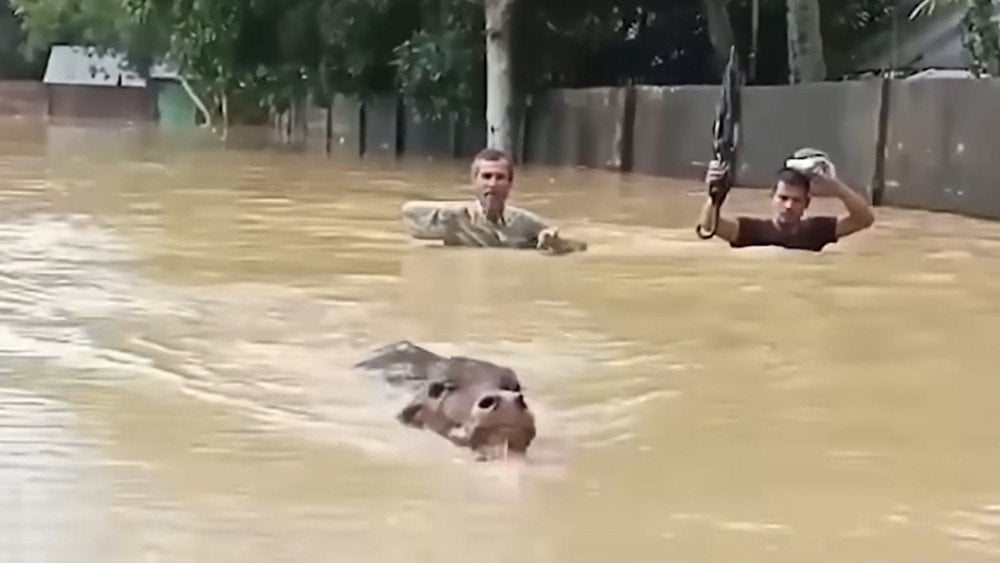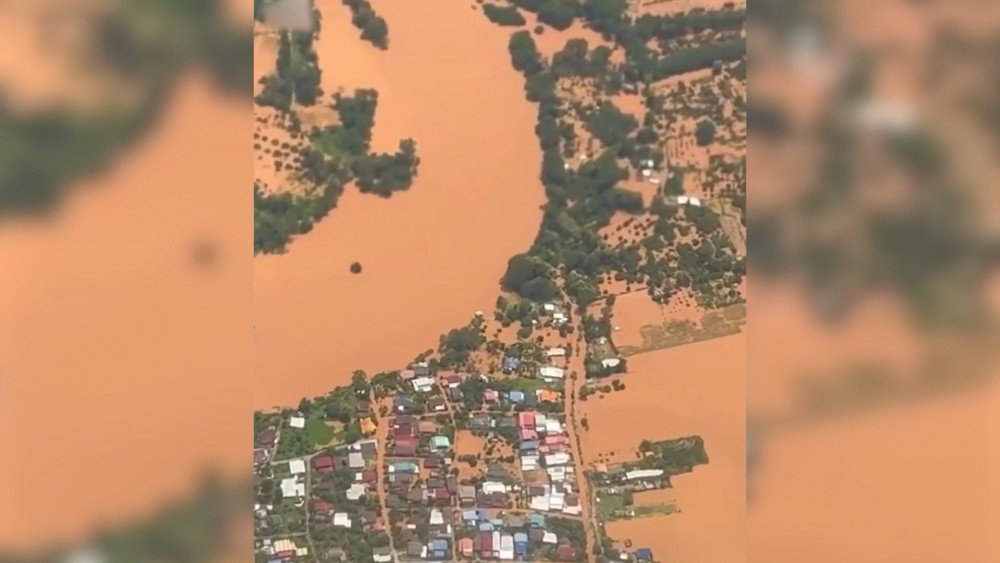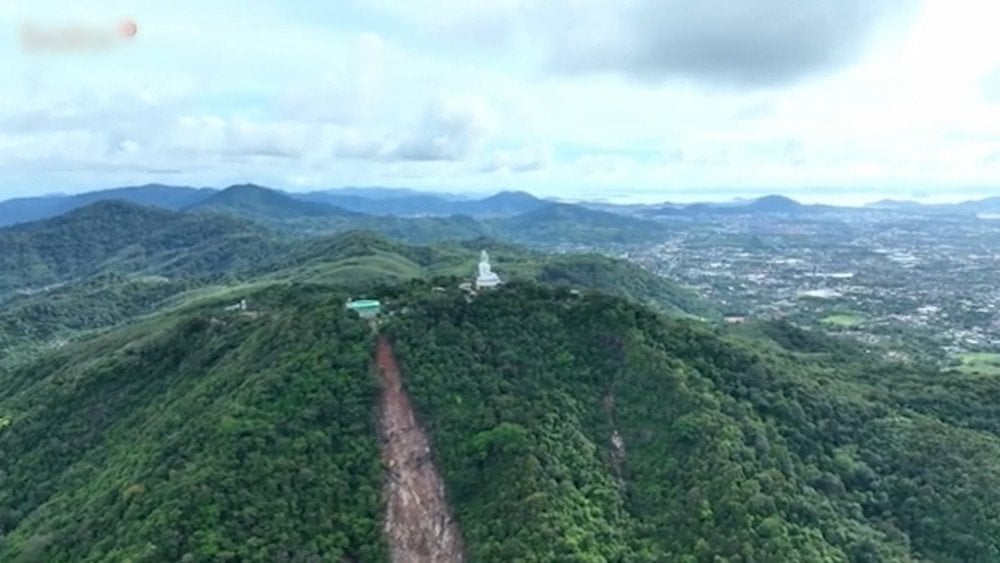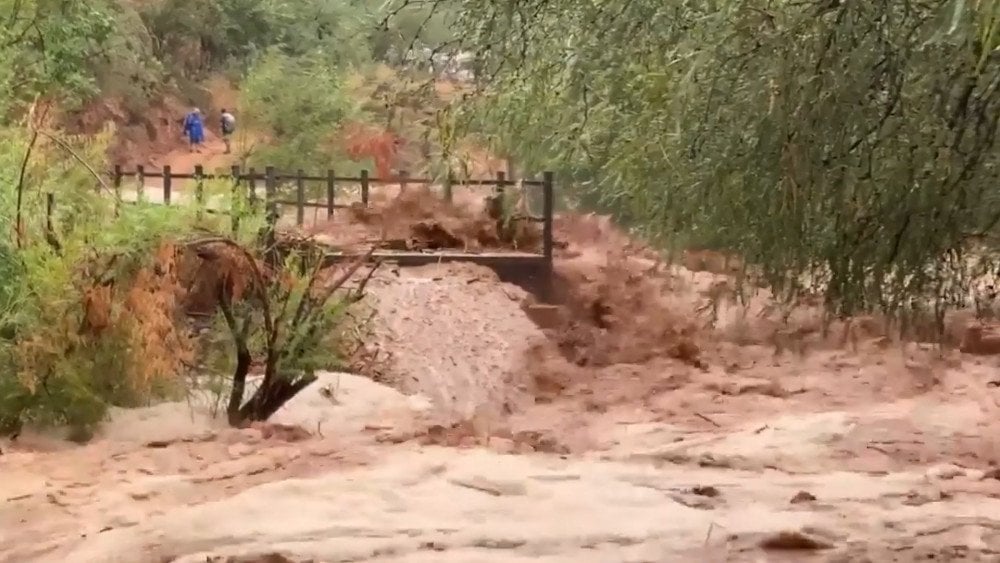Summary of Climate Disasters on the Planet from August 21 to 27, 2024
India
The Indian state of Tripura has been hit by the worst flooding in the last three decades.
Four days of continuous rain caused an extreme rise in river water levels, landslides, and widespread flooding,
affecting nearly 1.7 million residents across all eight districts of the state.
Over 117,000 people have been relocated to 557 temporary shelters.

Tripura state hit by severe flooding, India
As of August 26, 2024, according to the State Emergency Operations Center (SEOC), 26 fatalities were confirmed, and 20,300 homes were damaged.
According to the state's Minister of Energy, in the Gomati district alone, rainfall reached 656.6 mm (25.8 inches), which is 234% above the norm.
The India Meteorological Department (IMD) has issued the highest red alert across 3 districts of Tripura state, and an orange alert in 5 districts.
Bangladesh
Heavy rains have also caused sudden severe flooding in the neighboring Bangladesh, creating a nightmare for millions of residents.

Heavy rains flooded entire settlements, Bangladesh
Entire settlements were completely submerged, and hundreds of thousands of people were forced to seek shelter. At least 415,273 people were placed in 3,654 temporary shelters.
According to the Ministry of Disaster Management and Relief, as of August 25, at least 20 people have died and over 5 million people have been affected across 11 districts of the country. The hardest-hit districts were Noakhali, Feni, and Comilla.
Experts estimate that the water levels rose faster and in larger volumes than expected, greatly complicating rescue operations and causing enormous economic losses. Fish farms, rice fields, and vegetable gardens were heavily impacted, and roads and bridges were partially or completely destroyed.
A total of 1,047,029 people were trapped by floodwaters, without electricity, clean drinking water, or access to food. More than 887,000 families had no access to drinking water. As of August 25, about 1.1 million people remained without power.
Japan
On August 21, heavy rains hit Tokyo, Japan. According to the Japan Meteorological Agency,
a record 100 mm (3.9 inches) of rain fell in the Minato district in just one hour.
Some Tokyo Metro stations, such as Ichigaya and Shinjuku, were heavily affected, with water pouring from ceilings and staircases in the passages turning into waterfalls.

Flooded metro station in Tokyo, Japan
Rainwater overwhelmed the drainage system, forcing a manhole cover to shoot up and sending a water column several meters high into the air. The road under the Odakyu Line viaduct in the Shibuya area was flooded. Floodwaters, reaching up to 1.5 meters (4.9 feet), trapped three cars and a truck. Drivers were unable to open their vehicle doors due to the water. Fortunately, no casualties were reported.
Thailand
In Thailand, the heaviest rains and subsequent floods and mudslides claimed the lives of at least 22 people, with 20 more injured. According to the Department of Disaster Prevention and Mitigation (DDPM), 30,953 households were affected.

Powerful flood in Thailand
Between August 16 and 26, flash floods hit 13 provinces across the country, from the north to the south. As of August 26, 75,393 hectares (186,365 acres) remained flooded including 40,378 hectares (99,767 acres) of rice fields, in the provinces of Chiang Rai, Phayao, Lamphun, Phrae, Sukhothai, Phichit, Phitsanulok, and Nakhon Sawan.
A major tragedy struck the famous tourist island of Phuket, Thailand. In the Mueang district, about 200 mm (7.9 inches) of rain fell overnight from August 22 to 23. This continuous heavy rain caused a deadly landslide.
A mudslide came down from Nakkerd Hill, a popular tourist spot where almost all visitors come to see the giant 45-meter (148-foot) Buddha statue and panoramic views of the island.

A deadly landslide came down from Nakkerd Hill, home to the famous landmark — the giant Buddha statue — on the island of Phuket, Thailand
Unfortunately, the landslide hit at 5 a.m. local time when most people were still asleep. The incident has resulted in 13 deaths.
Saudi Arabia
From August 21 to 23, the Kingdom of Saudi Arabia issued a maximum, red-level alert for the provinces of Mecca, Al-Baha, Asir, and Medina due to extreme weather conditions.
The region was hit by torrential rains, gusty winds, and dust storms, which led to reduced visibility and halted road traffic. Residents and visitors in Mecca were surprised by an unusually intense thunderstorm with thunder and numerous lightning strikes.

Severe thunderstorm with intense lightning, Saudi Arabia
In Medina, a torrent of water swept away a group of people in vehicles, but fortunately, all were rescued.
On August 24, a powerful rockfall occurred in the Assalan Gorge, Asir Province, blocking the Mahayil – Bahr Abu Sakinah road and blanketing the area in a thick layer of dust.
USA
On August 22, heavy rains fell in Grand Canyon National Park, Arizona, USA,
and within just 30 minutes, a sudden, powerful flood occurred.
The water washed away several bridges and
trapped 200 hikers
in the Havasu Falls area.

Raging water destroying a bridge, Arizona, USA
A raging current swept away a woman. Unfortunately, she did not survive.
In several states across the country on August 26, massive hail fell. The Great Lakes region was hit by a series of storms. Winds reached speeds of 122.3 km/h (76 mph), comparable to a Category 1 hurricane, leaving over 400,000 electricity consumers without power.
In Woodstock, Illinois, hailstones over 6 cm(2.4 inches) in size fell while in O’Neill, Nebraska, 10 cm (4-inch) hailstones damaged vehicles.
Abnormal Hail
Vehicles were also damaged by large hail in Australia, Spain, and the Altai Republic in Russia.
In the province of Brescia, Italy,
hailstones the size of eggs struck the area.
In the commune of Coccaglio, the hail damaged roofs and building structures and caused significant harm to vineyards. Town streets turned into rivers of hail.

Hailstorm turned streets into rivers, Brescia Province, Italy
Sudan
In northeastern Sudan, the collapse of the Arbaat Dam, located 20 km (12 miles) from Port Sudan in the Red Sea state, led to catastrophic flooding.
Torrential water currents literally wiped out 20 villages
in nearby areas, and another 50 villages were severely impacted.

Catastrophic flood inundated homes and streets, Sudan
Around 50,000 people were left homeless. Fleeing from the floods, villagers sought refuge in the mountains, only to face a new threat—snakes and scorpions.
According to the state news agency SUNA, 132 people have died due to heavy rains and the dam collapse.
China
While floods in the desert regions of Saudi Arabia have become somewhat expected in recent times, the flooding of the Taklamakan Desert in China greatly surprised local residents.
Social media comments included: “Who would ever connect a desert with floods?”, “Even a camel could never have imagined drowning” and “Nature really knows how to surprise us...”
On August 24, floodwaters submerged a road in the desert, causing some vehicles to stall.
A few days earlier, in Suizhong County, Huludao City, Liaoning Province,
rainfall over 12 hours equaled the region's typical annual total.

Floodwaters washed away dozens of vehicles in Liaoning Province, China
This set a new record for the city since meteorological observations began in 1951.
The heavy rains resulted in 10 deaths, with 14 people reported missing. In Huludao alone, 188,757 people were affected.
Abnormal precipitation was also observed in other countries around the world. And these are far from the only cases from the past week.
These unprecedented rains and powerful floods are driven by record ocean and atmospheric warming. The ocean plays a key role in regulating the planet's temperature: it transfers excess heat from the Earth's interior into the atmosphere and then into space. However, due to hydrocarbon pollution, the ocean’s heat conductivity has been significantly disrupted. An overheated ocean evaporates more moisture, and a warmer atmosphere can retain more of it. As a result, scientists have recorded a significant increase in atmospheric moisture content. People in various countries are experiencing this through extreme downpours and subsequent floods, which we cover in our weekly summaries.
The question arises: is there really something that can be done about this? Yes, there is. At present, such technology already exists. It’s called the Atmospheric Water Generator (AWG). With widespread use, atmospheric generators could serve as an artificial filter integrated into the planet's water cycle. Over a few years of active use, these devices could significantly purify the ocean and atmosphere. Additionally, as intense evaporation decreases, the ocean will start to cool down. Using AWGs will also cool and dehumidify the atmosphere, reducing the strength of hurricanes and storms and decreasing the occurrence of extreme precipitation. This could save millions of lives and prevent billions in damages.
This also answers one of the most frequently asked questions in the comments: how can we clean the ocean of all pollutants? There is no need to filter water from the ocean—it’s enough to extract it from the air.
We invite you to watch the full version of the documentary, which explains the already operational AWG systems and future plans for their deployment and scaling.
You can view the video version of the article here:
Leave a comment